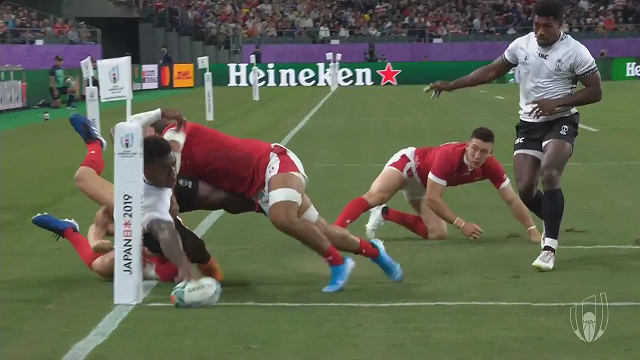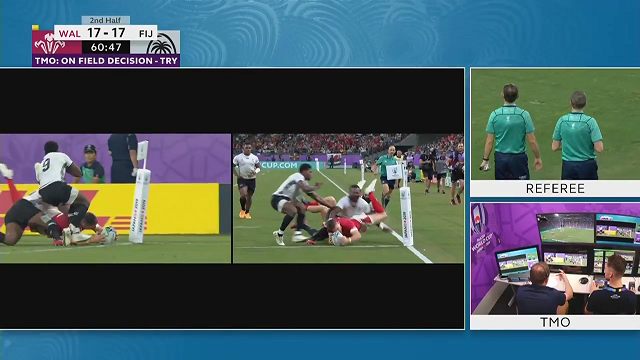How to cross the finishing line in the modern game
In American Football, players don’t have to touch the ball down on the ground to score. All they have to do is ‘break the place of the end zone’ while still in possession of the ball.
An imaginary line is drawn vertically from the goal-line. The ball-carrier can be pushed back or away from end zone subsequently, but if the ball crosses that imaginary line even momentarily, a touchdown has been scored. The scoring zone is therefore three-dimensional rather than two-dimensional.
While Rugby Union remains insistent upon the grounding of the ball by pressing down on it with the hand or arm in the in-goal area, it approximated the three-dimensional idea of the scoring zone much more nearly when it ruled, in a change to Law 21, section 16 that:
If the ball or ball-carrier touches a corner flag or corner flag post without otherwise being in touch or touch-in-goal, play continues unless the ball is grounded against the post.
View the video example from a game between Ireland and Romania
The notion of the corner-flag no longer being ‘in touch’ has opened up the idea of three-dimensional try-scoring for the finishers in a Rugby Union team. In other words, a ball-carrier can now exploit the space above the try-line, and outside the side-line, without fear of being ‘in touch’.
There were three excellent examples of how acrobatic and spectacular finishes in the modern game have become with the benefit of the recent ruling, in the World Cup group game between Wales and Fiji.
The first instance occurred in only the 4th minute of the match, with the ball in the hands of Fijian right wing Josua Tuisova
Tuisova bludgeons his way past two Welsh tacklers to put the ball down over the goal-line in the right corner, but in real time considerable doubt remained over whether he was already in touch while doing it.
The slow-motion replay reveals far more, from the angle behind the posts.
This angle illustrates with much greater clarity how a finisher can now use the three-dimensional space above and beyond the side-line, because the corner flag is now ‘live’ and in the field of play.
Roughly 70% of Tuisova’s body has already broken the plane of the touch-line as he grounds the ball one-handed:

Effectively the scoring zone near the corner-flag has been significantly enlarged, and the need for exceptional body-control by finishers in this area has grown with it.
The second example was a marginal ‘fail’, by Tuisova’s opposite number Josh Adams in the 27th minute of the first half
As Adams goes to ground the ball over the try-line, all of his lower body below the hips is ‘in touch’, but above the whitewash and therefore still in play.
In the event, and after consultation with the TMO, referee Jerome Garces ruled that Adams’ big toe had scraped the chalk immediately before the action of touching down – but it was a damned close-run thing:

At the moment of touching down itself, Adams’ feet are in the air and therefore they are okay.
Josh Adams finally managed to get his revenge on Josua Tuisova on the hour mark, supporting a break by outside centre Jonathan Davies down the left:
Once again, in real time it is impossible to judge whether Adams has been driven into touch before grounding the ball over the Fijian try-line in a chaotic tangle of arms and legs.
Again it was left to the TMO to sort the facts from the fiction:

At the key moment, both of Josh Adams’ feet (in the white boots) are in the process of breaking the plane of the side-line, but crucially they are still suspended above it as he puts the ball down. That extra scoring space has been created by removing the deterrent of the corner flag for prospective try-scorers.
Those three refereeing decisions, balanced on the sharpest of knife-edges even in replay, represent a swing of 21 potential points towards one side or the other.
Finishers now need to show much greater awareness of the three-dimensional nature of the scoring zone near the corner-flag. They can collide with the flag itself, and suspend their bodies in the space above and beyond the side-line, if they can get the ball down before they return to earth ‘in touch’. The demands on body-control are gymnastic in nature, but the potential rewards are far, far too good to pass up.












.jpg)

.jpg)







